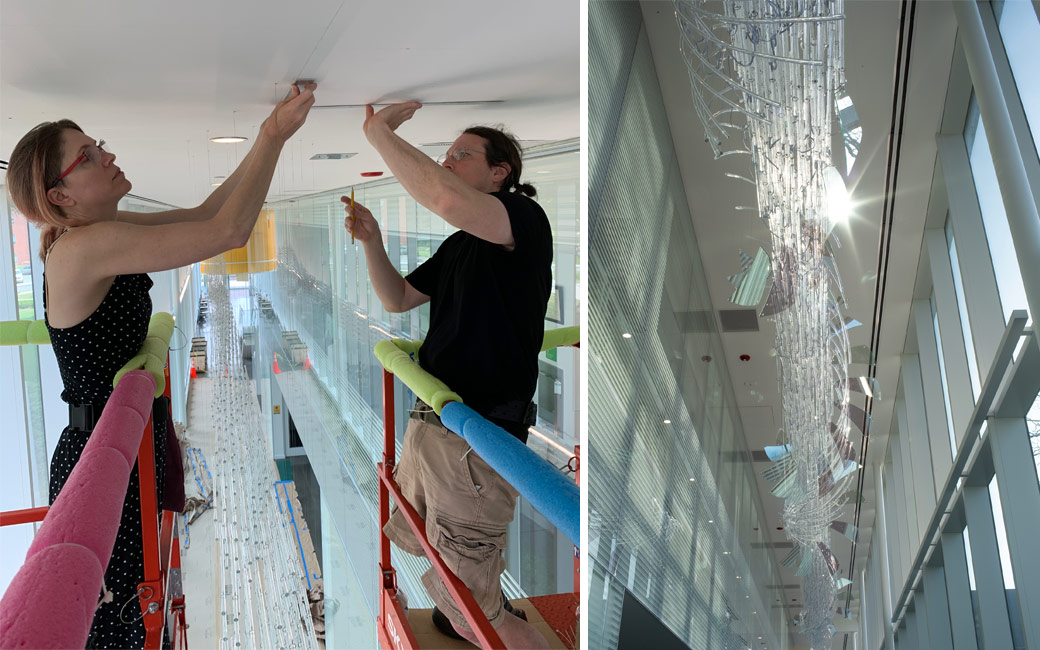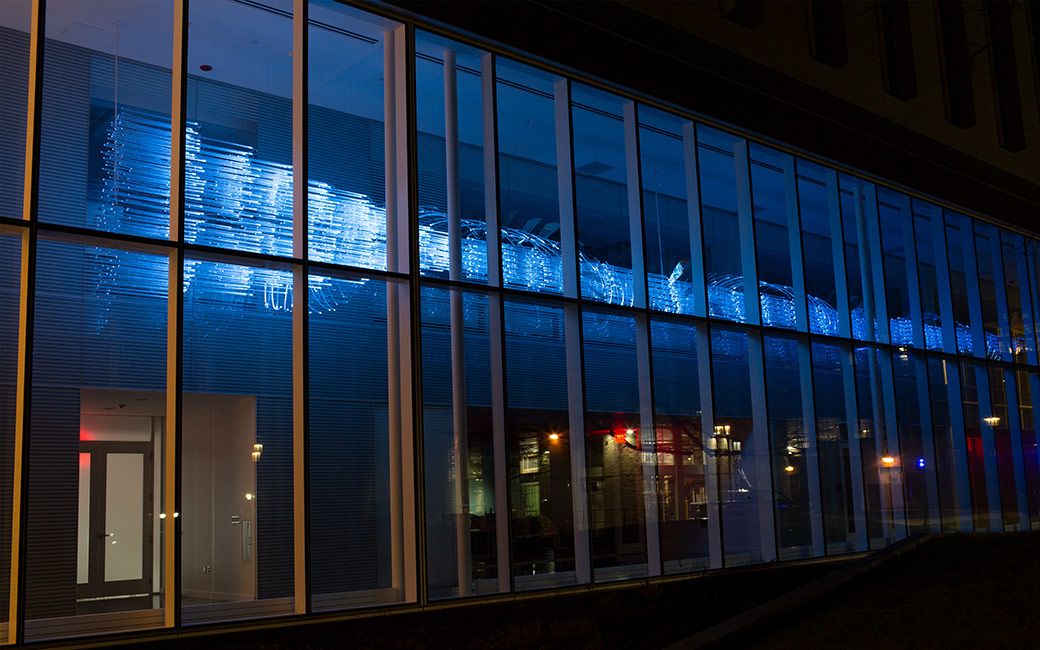TU faculty blend art, engineering in large-scale, data-fed sculptures
Jenn Figg, Matthew McCormack push the limits of art and science in works commissioned by the Rhode Island State Council on the Arts, University of Rhode Island
By Rebecca Kirkman on July 20, 2022

At sunset, the 1,650 pieces of mica embedded in the handmade glass composing “Light Pressure,” a 100-foot-long sculpture suspended from the ceiling of the Fascitelli Center for Advanced Engineering at the University of Rhode Island, begin to sparkle.
After dark, the work changes completely as 2,000 individual LEDs illuminate the sculpture with gently fading, colorful light patterns inspired by the transmission of energy.
The Internet-connected sculpture reads the time of day, temperature, certain aspects of weather and the tides in real time. The result is data-fed drama.
“The light patterns are continually changing,” says Jenn Figg, associate professor in the Department of Art + Design, Art History, Art Education at the College of Fine Arts and Communication, who created the work with artistic collaborator and TU adjunct professor Matthew McCormack. “This is something the engineers were really excited about—the sense that art and engineering are linked.
“[The disciplines] follow a very similar process of investigation. There’s an idea, you investigate that idea, then you try a number of things to get to the result. There’s no set hypothesis, but you’re trying to build something to solve a problem or create a new idea.”
“Light Pressure” is the largest of four works commissioned by the Rhode Island State Council on the Arts and the University of Rhode Island for URI’s newly constructed College of Engineering building. “Droplets,” a series of three site-specific sculptures also suspended from the ceiling, are constructed from mold-blown and kiln-formed glass and fitted with light nodes.
It’s the largest-scale commission yet for the duo, who began collaborating in 2009 and building their portfolio of private and public, large-scale installations in 2013. “We make a lot of objects and installations, and some of the main conceptual concerns we have are [about] energy,” Figg says. “How energy is used, how it’s transformed, how it’s visualized. That can come in many forms, but one of the main forms is light.”
“ We’ve taken on and imagined more and more impossibility. We ask, ‘What is impossible? Let’s run toward that.’ ”
Installed in summer and fall 2021, “Light Pressure” and “Droplets” are the culmination of years of research that began when Figg and McCormack’s proposal was selected from more than 260 applicants in 2017.
At an early site visit, Figg and McCormack met with URI engineering dean Raymond Wright alongside engineers, architects and project managers.
“We walked around in the ironwork and mud and were fascinated,” Figg recalls. “They had a lot to say about engineering and what it means to them. Everything was incredibly passionate. While it was very structured, it was very open to interpretation. So we listened to everything they said and how it dovetailed with our art, what we do and what we're interested in.”
Inspiration for the design incorporates College of Engineering faculty research on finding the speed of sound under water as well as magnetic fields, turbine blades, laser beams and hydrophobic nanostructures—man-made surfaces that repel water.
The TU duo’s perspective won over the panel.
“Jenn and Matthew clearly had thought out the relationship of engineering to the arts, bringing into beautiful artistic harmony geometrical shapes with their own engineering significances,” says Peter Swaszek, associate dean for academic affairs at the URI College of Engineering. “Combined with the high technology of the materials and the computer-driven lighting, they made the panel’s task of choosing very easy.”
Because the commission was for a building under construction, the artists collaborated with the engineers, architects and designers on the installation of the projects.
“It was one of the first times that we’ve been able to sit down with architects—and they had in-house engineers—in a completely collaborative and thoughtful process,” Figg says. “Normally architects don't want to let go, engineers aren’t available to do that. This time, our work was streamlined into the building, and they even changed some of the architecture around it, for example, putting in glass balconies, to make sure you could see the artwork.”

Suspended from the ceiling along a gallery hallway fully encased in glass windows on one side and glass classrooms and labs on the other, “Light Pressure” is also visible from the stairs.
“How can you create a sculpture that is readable and exciting from every angle?” Figg asks. “There’s no single primary viewpoint. It's an experiential sculpture.”
Figg and McCormack began making the glass—embedding it with mica, a mineral that reflects light, pulling hundreds of straight rods and twisting cane at Pittsburgh Glass Center and Columbus, Ohio-based Glass Axis—in summer 2019.
To create the sculptures, the artists combine ancient glassblowing techniques like caneworking, where glassblowers pull and twist glass softened in a 2,000-degree-Fahrenheit kiln into thin rods, with modern tools and engineering, including 3D computer-aided design and automated machining tools like 3D printers and laser-, plasma- and waterjet-cutting machines.
“These projects were not achievable without those machines,” Figg explains. “We made a blow mold shaped like a diamond that was 100% 3D designed—a milled piece of steel that was welded together. This is all the work that completely fades to the background when you see the structure.”
The summer 2020 installation of the sculptures was put on hold first by the COVID-19 pandemic and then by the news that the work would require a UL listing, a rigorous process verifying electrical elements used meet industry standards.
When installation began in late May 2021, Figg and McCormack tackled the challenges that come with building the piece in the space, with the help of three URI students—two recent alumni from the art department and a current nursing student.
“This shows that art can be a part of everyone’s life,” Figg says of the URI assistants. “The nursing student had such attention to detail, such nimble fingers and an eye for being exacting that she was invaluable.”
“We knew there were going to be all kinds of problems on site,” Figg says. “We made everything by hand, created all the LED caps, thought about how they were all going to be snap fit to the glass and wired.”
Don't let data worries keep you from Twitter.
— Twitter (@Twitter) August 13, 2018
https://t.co/vt2K81Cnf3
But when they began installing the work on site, things changed. “We had all of these holes in the ceiling we had to fill. We had to keep the wires from scraping drywall if there was movement but hide where they come out of the ceiling. We brought our 3D printer with us, and we were printing almost every day.”
They also planned for inevitable breakage. “We [typically] lose 20% of the glass along the way,” Figg says.
Installation of the pieces continued after the building’s grand opening and into the start of URI’s fall term, wrapping in October 2021.
Throughout the process, the artists built relationships with the URI community.
“Jenn and Matthew were terrific to work with. They went out of their way to describe in great detail the entire process, from fabrication of the individual pieces to placement of each. And they did this not only with college administrators but with whomever was interested,” says Swaszek, recalling a time when he saw Figg chatting with a retired staff member. “They helped us own and feel a part of the installation by teaching us so much about their concept and product.”
Working on such large-scale commissions informs Figg’s approach with TU students in the classroom.
“I know the difficulty in ideation, conceptualization and creation,” she says. “The thing that's most important to me is the concept that drives the entire undertaking. That's one of the things that I come back to in class—'What is your idea?’”
She also shares her extensive research process. “I want everyone to do research. They have their idea, but what is informing their idea? What else are they looking at? We don’t make art in a vacuum,” Figg says.
While it’s one thing to master the tools, techniques and material, she says it takes a nimble mind to combine those skills with a great idea. “That’s what I ask my students: to be very agile and to take risks. I take risks all the time and not everything is a success. And that can be really scary.”
Figg and McCormack push past that place of fear to reach for the unimaginable.
“We’ve taken on and imagined more and more impossibility,” Figg says. “We ask, ‘What is impossible? Let’s run toward that.’”
This story originally appeared in the Spring 2022 issue of COFAC Today.